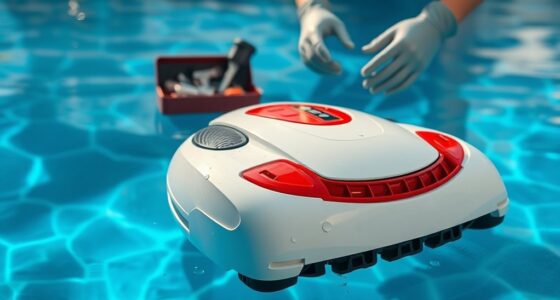Oxygen bleach and chlorine bleach differ mainly in their chemical makeup and use. Chlorine bleach, containing sodium hypochlorite, acts quickly to disinfect, whiten, and remove tough stains but can damage delicate fabrics and surfaces. Oxygen bleach, made from compounds like sodium percarbonate, is gentler, safe on colors, and environmentally friendly. Understanding these differences helps you choose the right option for your laundry and cleaning needs, so if you keep exploring, you’ll find out more about how each works best.
Key Takeaways
- Chlorine bleach contains sodium hypochlorite, offering quick whitening and disinfection, but can damage delicate fabrics and surfaces.
- Oxygen bleach releases oxygen with water, brightening fabrics gradually and safely, especially on colored or sensitive items.
- Chlorine bleach is more environmentally harmful, producing toxic byproducts and having a strong smell, while oxygen bleach is biodegradable.
- Use chlorine bleach for disinfecting whites and mold removal; oxygen bleach is ideal for everyday laundry and colored fabrics.
- Oxygen bleach is safer for skin, household surfaces, and eco-conscious cleaning, whereas chlorine bleach requires caution and protective gear.

When choosing a bleach for cleaning or whitening, understanding the differences between oxygen bleach and chlorine bleach is essential. Both are effective stain removers, but they serve different purposes and come with distinct advantages and drawbacks. Knowing which one suits your needs can help you avoid damage to fabrics, surfaces, or your health.
Chlorine bleach, also called sodium hypochlorite, is a powerful disinfectant and whitening agent. It’s widely used in laundry, disinfecting surfaces, and cleaning mold or mildew. Chlorine bleach works quickly, breaking down organic stains and bacteria efficiently. However, it’s quite harsh and can damage delicate fabrics or surfaces if not used carefully. It’s also known for its strong, pungent smell, which can cause respiratory irritation. Prolonged exposure or misuse may weaken fabrics, cause fading, or even create health concerns like skin irritation or respiratory issues. Chlorine bleach is also corrosive to certain materials, such as plastics and metals, so you need to be cautious about where and how you use it.
Chlorine bleach is a powerful disinfectant and whitener that can damage delicate fabrics and surfaces if misused.
On the other hand, oxygen bleach, often labeled as color-safe or non-chlorine bleach, is gentler and more environmentally friendly. It typically contains compounds like sodium percarbonate or sodium perborate, which release oxygen when dissolved in water. This oxygen action lifts stains and brightens fabrics without the harsh chemicals found in chlorine bleach. Because of its mild nature, oxygen bleach is safe for colored fabrics and delicate items, making it ideal for everyday laundry. It’s also less likely to cause damage to surfaces or irritate your skin and respiratory system. Plus, oxygen bleach is biodegradable, making it a more eco-conscious choice.
While chlorine bleach acts quickly and is excellent for disinfecting and whitening heavily stained whites, it’s not suitable for all surfaces or fabrics. Oxygen bleach, however, works more gradually but is versatile, safe for colors, and can be used on a variety of household surfaces without risking damage. If you’re cleaning mold, whitening white clothes, or disinfecting, chlorine bleach might be your best option—just remember to use it with proper ventilation and protective gear. For everyday laundry tasks, especially when you’re concerned about colors or sensitive skin, oxygen bleach is a safer, more sustainable option.
Frequently Asked Questions
Is Oxygen Bleach Safe for All Colored Fabrics?
Oxygen bleach is generally safe for all colored fabrics, but you should still test a small area first to prevent any potential discoloration. Unlike chlorine bleach, oxygen bleach is gentler and less likely to fade colors. Always follow the manufacturer’s instructions and avoid using it in high concentrations or with delicate fabrics. When in doubt, check the care label to ensure compatibility with oxygen bleach.
Can Chlorine Bleach Be Used on Delicate Materials?
No, you shouldn’t use chlorine bleach on delicate materials. It’s harsh and can weaken fibers, causing damage or discoloration. Instead, opt for oxygen bleach or gentle, fabric-safe cleaning solutions designed for delicate fabrics. Always check the care label first, and test any new product on a small, hidden area before full application. This way, you protect your delicate items while keeping them clean and bright.
How Long Does Each Type of Bleach Last?
Bleach’s lifespan varies with usage and storage. Chlorine bleach typically lasts about six months to a year if unopened but can lose potency sooner once opened. Oxygen bleach, being gentler, often remains effective for up to a year or more if stored properly in a cool, dry place. To maximize freshness, always seal containers tightly and avoid exposing them to extreme temperatures or sunlight.
Are There Environmental Impacts of Using Oxygen vs. Chlorine Bleach?
You’ll find that oxygen bleach is more environmentally friendly because it breaks down into water and oxygen, reducing pollution. Chlorine bleach releases harmful chemicals that can harm aquatic life and contribute to water pollution. By choosing oxygen bleach, you minimize ecological damage, avoid toxic residues, and support safer waste disposal. Overall, oxygen bleach’s eco-friendly profile makes it a better option for those concerned about environmental impacts.
Can Oxygen Bleach Remove Stubborn Stains Better Than Chlorine Bleach?
Imagine a gentle tide sweeping away stubborn dirt—you’ll find oxygen bleach often does a better job on tough stains. Unlike chlorine bleach, which can sometimes be too harsh, oxygen bleach penetrates deeper and lifts stains more effectively without damaging fabrics. You’ll appreciate its ability to brighten whites and remove stubborn spots, especially on delicate materials. So, if stubborn stains are your challenge, oxygen bleach is your more gentle yet powerful ally.
Conclusion
Remember, not all that glitters is gold, and the same goes for bleach types. Oxygen bleach is gentler and eco-friendly, perfect for delicate fabrics and stains, while chlorine bleach offers powerful whitening for tough jobs. Choose wisely based on your needs to keep your laundry safe and effective. When in doubt, it’s better to be cautious than to regret — after all, a little knowledge goes a long way in making the right choice.









